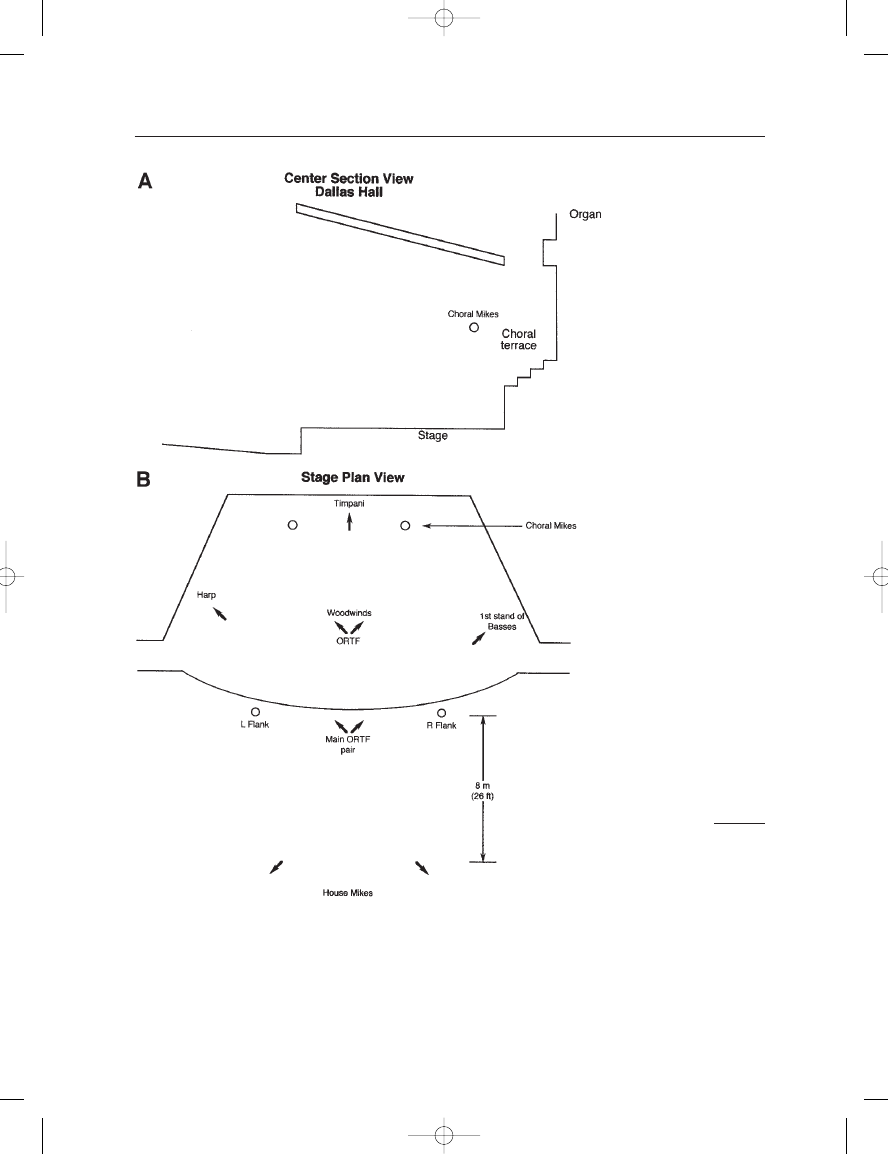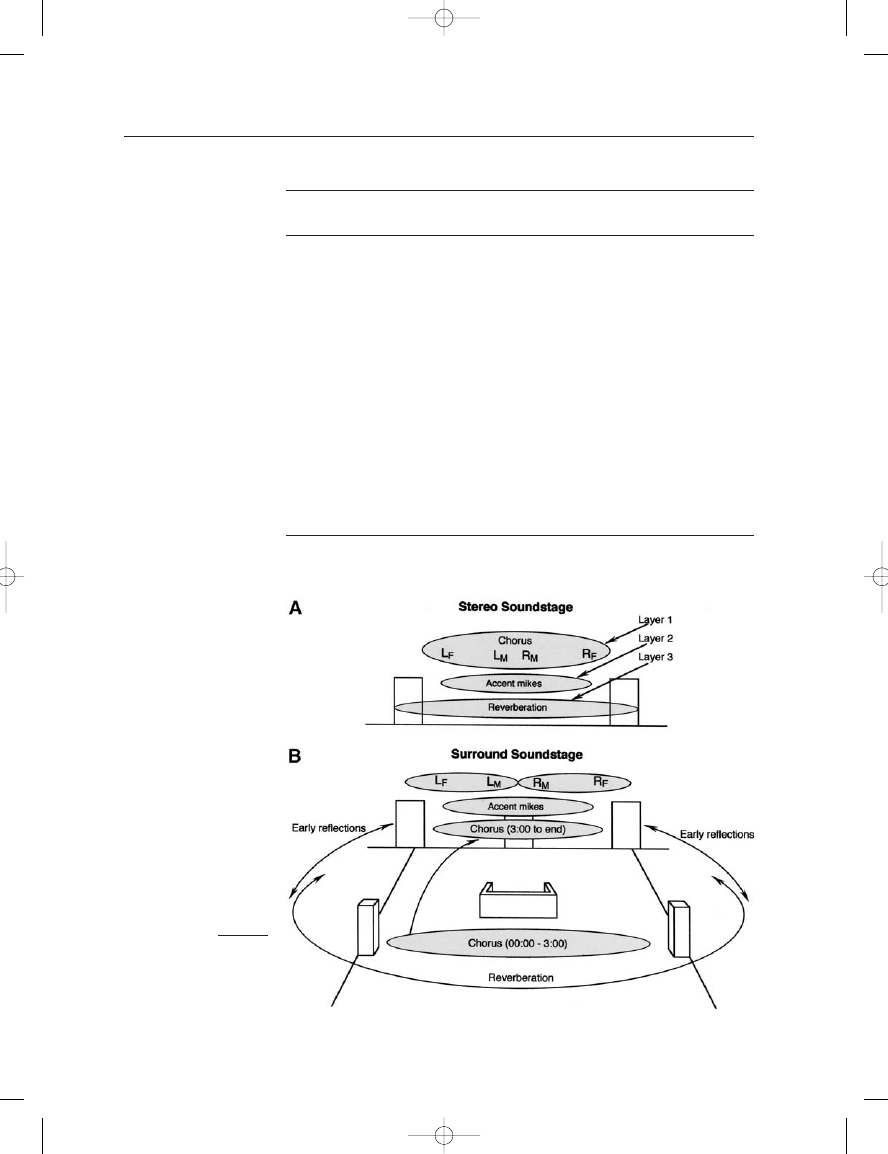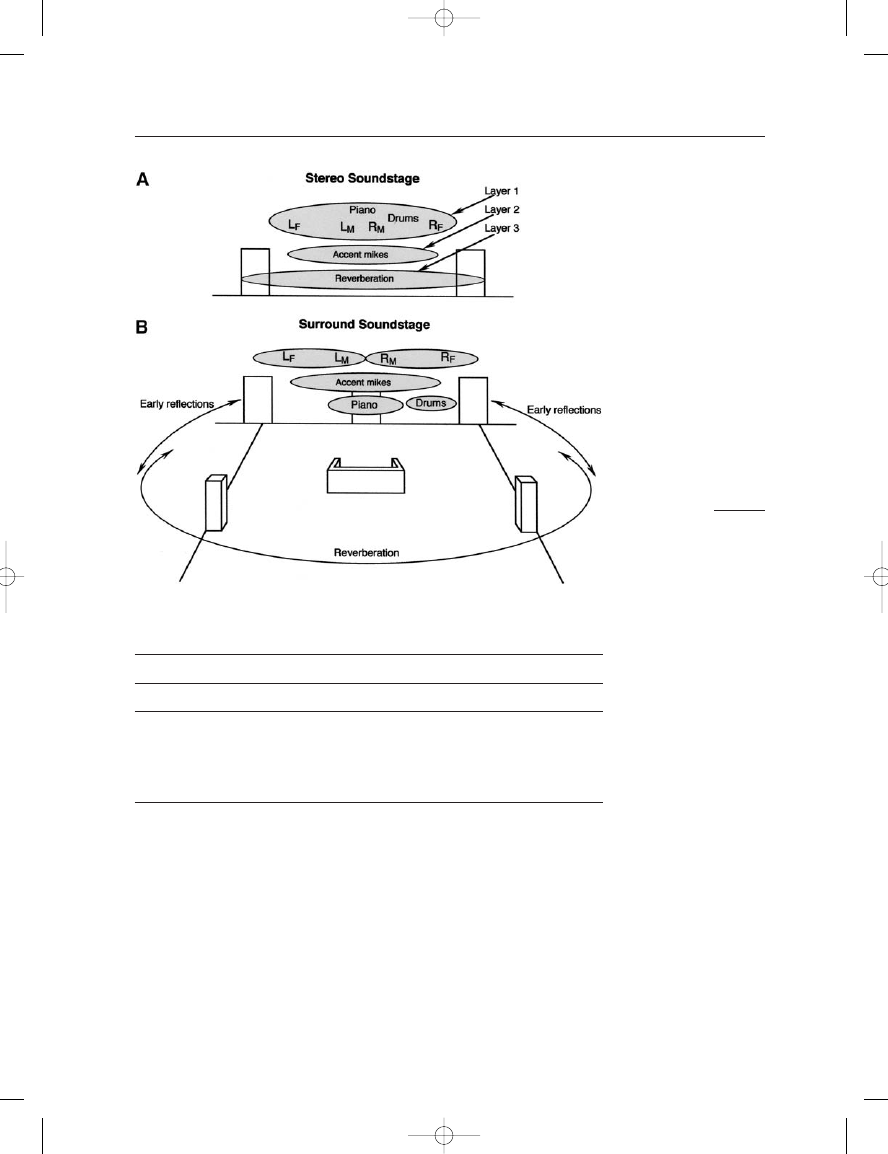ВУЗ: Казахская Национальная Академия Искусств им. Т. Жургенова
Категория: Книга
Дисциплина: Не указана
Добавлен: 03.02.2019
Просмотров: 17271
Скачиваний: 51

these microphones were progressively panned to front left and right.
Stage details are shown in Figure 16–4. The stereo and surround sound-
stages are shown in Figure 16–5. In setting up the surround mix, the
main microphone pair was demixed and re-panned center left and right
in order to produce a center channel. All accent microphones appear
THE MICROPHONE BOOK
278
FIGURE 16–4
Stage and microphone
layout for 1812 Overture:
center section view (A);
plan view (B).
Earg_16.qxd 14/9/04 2:58 PM Page 278

16: Surround Recording Case Studies
279
TABLE 16–2
Microphone Deployment for 1812 Overture
Position
Description
Stereo Stage
height
Track
panning
assignment
Major components
Stereo mix left
Track 1
Stereo mix right
Track 2
L flank
omni
left
3.5 m (12 ft)
Track 7
L ORTF
cardioid
left
3.5 m (12 ft)
Track 3
R ORTF
cardioid
right
3.5 m (12 ft)
Track 4
R flank
omni
right
3.5 m (12 ft)
Track 8
L chorus
omni
left
4.5 m (14.5 ft)
R chorus
omni
right
4.5 m (14.5 ft)
L house
cardioid
left
4 m (13.3 ft)
Track 5
R house
cardioid
right
4 m (13.3 ft)
Track 6
Accent microphones (these appear only in the stereo mix)
L woodwinds
cardioid
half-left
3.5 m (12 ft)
R woodwinds
cardioid
half-right
3.5 m (12 ft)
Harp
cardioid
left
1 m (40 in)
Timpani
cardioid
half-left
2 m (80 in)
Basses (1st stand)
cardioid
right
2 m (40 in)
FIGURE 16–5
Recorded soundstages for
1812 Overture: stereo
soundstage (A); surround
soundstage (B).
Earg_16.qxd 14/9/04 2:58 PM Page 279

only in the front left and right channels. The house microphones were
located 8 m (27 ft) from the main pair and were panned into the rear
channels. They were aimed at the upper back corners of the house.
The opening of this work as auditioned in surround sound is an
excellent example of the condition shown in Figure 15–3, in which all
channels contain mutually uncorrelated reproduction of the chorus.
Positioning the chorus at the back of the surround soundstage during the
open measures of the work was purely experimental – but is musically
appropriate and does not sound contrived.
RHAPSODY IN BLUE BY GEORGE GERSHWIN
The work was performed by Andrew Litton, pianist and conductor, and
the Dallas Symphony Orchestra in McDermott Hall at the Meyerson
Symphony Center. The normal orchestral forces were reduced to 25 players,
in keeping with the original arrangement of the work for the Paul
Whiteman Orchestra in 1924. In this regard the recording is more like
that of a studio orchestra than a full symphonic ensemble, and micro-
phone distances were reduced slightly for more presence. The cover of
THE MICROPHONE BOOK
280
FIGURE 16–6
Stage and microphone
layout for Rhapsody in
Blue.
Earg_16.qxd 14/9/04 2:58 PM Page 280

the piano was removed and the instrument oriented as shown so that the
conductor–pianist had direct eye contact with the players. Close pickup
of the piano, within 0.5 m (20 in), was mandated by the high ambient
orchestral levels surrounding the instrument. Figure 16–6 shows the
stage and microphone layout. Microphone deployment details are shown
in Table 16–3. The stereo monitor mix was assigned to tracks 1 and 2 of
the digital recorder.
Details of the stereo and surround soundstages are shown in
Figure 16–7.
The solo piano is a dominant feature in this recording and as such
needs to be positioned slightly in front of the orchestra. After some
experimenting in postproduction it was felt that the direct sound of
the instrument needed to be present in all three frontal loudspeakers, as
discussed in Chapter 15 under Frontal Arrays. By using only partial sub-
tractive mixing, an approximate balance was reached, as shown in
Table 16–4.
The relationships given here produce a total relative level of 0 dB,
and the 3 dB advantage of the center channel ensures that the listener
will identify the source primarily at the center loudspeaker. The rear
channels were derived primarily from the two house microphones, sup-
plemented by a reduced signal, high-passed at 200 Hz, from the main left
and right ORTF pair.
16: Surround Recording Case Studies
281
TABLE 16–3
Microphone Deployment for Rhapsody in Blue
Position
Description
Stereo Stage
height
Track
panning
assignment
Major components
Stereo mix left
Track 1
Stereo mix right
Track 2
L flank
omni
left
3 m (10 ft)
L ORTF
cardioid
left
3 m (10 ft)
Track 3
R ORTF
cardioid
right
3 m (10 ft)
Track 4
R flank
omni
right
3 m (10 ft)
L solo piano
cardioid
left
0.5 m (20 in)
Track 7
R solo piano
cardioid
right
0.5 m (20 in)
Track 8
L house
cardioid
left
10 m (33 ft)
Track 5
R house
cardioid
right
10 m (33 ft)
Track 6
Accent microphones (these appear only in the stereo mix)
L woodwinds
cardioid
half-left
3 m (10 ft)
R woodwinds
cardioid
half-right
3 m (10 ft)
Orchestral piano
cardioid
left
1 m (40 in)
Violins
cardioid
half-left
2 m (80 in)
Brass
cardioid
half-right
2 m (80 in)
Bass and tuba
cardioid
right
2 m (80 in)
L drum set
cardioid
half-left
1 m (40 in)
R drum set
cardioid
half-right
1 m (40 in)
Earg_16.qxd 14/9/04 2:58 PM Page 281

OPENING HYMN FROM TE DEUM BY
HECTOR BERLIOZ
Berlioz’s Te Deum is a large work for orchestra, chorus, tenor solo, and
organ. It was performed with audience at the Cathedral of Saint John the
Divine in New York in 1996 during a convention of the American Guild
of Organists, Dennis Keene, conductor. The Cathedral is the largest gothic
structure in the world, with a nave extending 183 m (601 ft) front to back,
and the reverberation time of the occupied space is about 5 s. The orches-
tra was positioned in the large crossing, and the chorus was located on
multiple risers in the sanctuary. The vast dimensions of the space are such
that there are virtually no early reflections. The first reflections are from
walls that are about 25 m (83 ft) distant, so that the reflected sound blends
in comletely with the onset of diffuse reverberation.
THE MICROPHONE BOOK
282
TABLE 16–4
Solo Piano Balance in Rhapsody in Blue
Front Left
Front Center
Front Right
Piano level
–6 dB (1/4 power)
–3 dB (1/2 power)
–6 dB (1/4 power)
FIGURE 16–7
Recorded soundstages for
Rhapsody in Blue: stereo
soundstage (A); surround
soundstage (B).
Earg_16.qxd 14/9/04 2:58 PM Page 282